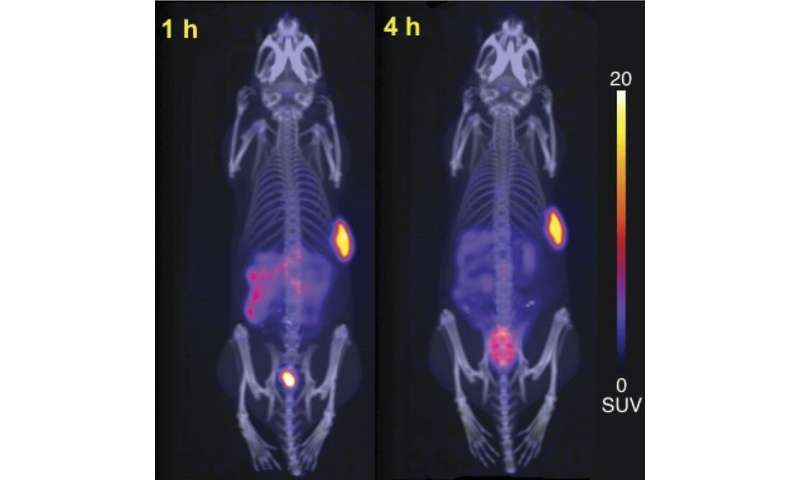New theranostic approach reduces tumor volume and increases survival in NET study


A pair of copper radionuclides that target the somatostatin receptor overexpressed in neuroendocrine tumors has proven successful in identifying tumors and improving survival. According to new research published in the December issue of The Journal of Nuclear Medicine, the imaging agent 64Cu-CuSarTate produced high-quality positron emission tomography (PET) images in a mouse model of neuroendocrine tumors, while its therapeutic counterpart, 67Cu-CuSarTate, was highly effective in reducing tumor volume and extending lifespan. The research also demonstrated the advantages of delivering the radionuclide therapy as two fractionated doses, as opposed to one.
Neuroendocrine tumors typically are diagnosed with 68Ga-DOTA-octreotate and treated with 177Lu-LuTATE peptide receptor radionuclide therapy. However, using two different chemical elements (Ga and Lu) can lead to inconsistent tissue biodistribution, as they do not have the same binding and internalizations interactions. “Ideally, a chemically identical ‘imaging-therapeutic’ pair of radionuclides bound to the same targeting agent should be used for diagnosis and treatment,” said Paul S. Donnelly, BSc(Hons), Ph.D., professor in the School of Chemistry at the University of Melbourne in Melbourne, Victoria, Australia.
In the study, researchers utilized a preclinical mouse model to explore the chemically identical radionuclide pair 64Cu-CuSarTate and 67Cu-CuSarTate. To assess the ability of 64Cu-CuSarTate to positively identify tumors, PET imaging occurred at one hour and four hours after injection of the radiotracer. On completion of the four-hour imaging, mice were euthanized and biodistribution studies were performed.
Multiple therapy experiments were also performed to evaluate the efficacy of 67Cu-CuSarTate. In the first, mice were injected with five MBq of 177Lu-LuTATE, five MBq of 67Cu-CuSarTate or saline and monitored for tumor growth. In the second experiment, mice were injected with a total of 30 MBq of 177Lu-LuTATE, 67Cu-CuSarTate or saline either as a single intravenous injection or as two 15 MBq fractions, two weeks apart; tumor growth was then monitored.
64Cu-CuSarTate PET images acquired at both one hour and four hours post-injection revealed very high tumor uptake and excellent tumor-to-background ratios. The high tumor uptake was confirmed with the ex vivo biodistribution analysis. Tumor growth was inhibited by 75 percent with 67Cu-CuSarTate treatment and by 89 percent with 177Lu-LuTATE, and survival was extended from 12 days in the control group to 21 days following treatment with both therapies. Treatment of tumors with two fractions of either 177Lu-LuTATE or 67Cu-CuSarTate significantly improved survival when compared to delivery as a single fraction. Equivalent efficacy was observed between the two therapies following treatment on both the single and fractionated schedules.
“Copper radionuclides are beneficial for several reasons,” said Rodney J. Hicks, MBBS, MD, FRACP, FAHMS, professor in the Sir Peter MacCallum department of oncology at the University of Melbourne, in Melbourne, Victoria, Australia. “The strong binding of copper within the tumor allows for increased detection of disease, which can serve to limit radiation exposure to normal tissues during therapy. The ability to image at multiple time points with 64Cu-CuSarTate supports prospective dosimetry for therapeutic treatment planning with 67Cu-CuSarTATE, which could potentially offer shorter cycling of treatment, particularly for more aggressively growing tumors.”
In terms of potential translation of the copper-64/67 theranostic pair to clinical studies, it is pertinent that copper-64 is produced in a cyclotron. The longer half-life of 64Cu-CuSarTATE as compared to 68Ga-DOTA-octreotate means that the tracer can be easily produced under good manufacturing practice conditions and transported regionally. 67Cu-CuSarTATE can be produced with linear-accelerators in high specific activity and radionuclide purity, so it is not reliant on nuclear reactors.
Source: Read Full Article